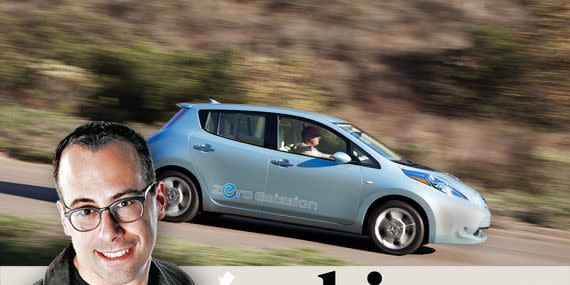As We Go Green with Clean Electric Cars, Somebody's Going to Get Dirty


To the golden and ocher Utah deserts, July 6, 1952, might as well be yesterday. On that Sunday, geologist and wildcat prospector Charlie Steen—face grimy with red dust, toes poking out from his busted boots, pockets nearly empty—drove his hobbling Jeep into Buddy Cowger’s gas station in tiny Cisco, Utah, with a black rock in the back. At Steen’s urging, Cowger waved his brand-new Lucky Strike Geiger counter at the rock. The needle went off the scale. After two years of roaming the Colorado plateau, Steen finally had discovered what the U.S. government was willing to pay royal ransoms for: a domestic uranium supply.
Wherever energy has been discovered in the past century, fortunes have bloomed. Four years after Steen’s find, McCall’s magazine described nearby Moab as the “richest town in the U.S.A.,” because there were 20 millionaires for every 250 citizens. Steen moved into a $250,000 mansion in Moab and bought a Cessna, which he flew once a week to Salt Lake City for rumba lessons.
The rural folk living around southwest Bolivia’s 4000-square-mile Salar de Uyuni salt flat may be in line for a similar Jed Clampett–like windfall. Uyuni’s huge concentration of lithium in its salty sands has earned it the title of the “Saudi Arabia of lithium.” Yes, that term is being thrown around a lot lately—the Pentagon used precisely the same words to describe Afghanistan—and the Bolivians are not the only ones in South America getting measured for sheik’s robes. Besides Uyuni, Argentina’s Salar del Hombre Muerto (“Salt Lake of the Dead Man”) and the salt playas in Chile’s high Atacama Desert represent about 80 percent of the world’s easily exploitable lithium reserves.
Lithium is in vogue. It’s the wondrous battery material underlying the latter-day increase in cell-phone power, laptop life, and the driving ranges of electric cars. Here’s why: Lithium is light—in fact, at No. 3 on the periodic table, it’s the lightest metal and least-dense solid element in nature—and its particular atomic properties mean it offers greater power density than other materials.
In a common lithium-ion battery cell, a solid of lithium-cobalt oxide coats one electrode, the cathode. Common carbon, often in the form of graphite, coats the anode. While the battery charges, the energy going in forces about half of the cathode’s lithium ions to migrate through the electrolyte to the anode, where they wait for the opportunity to return to their brothers on the cathode. Step on it in your electric car, or switch on your phone, and the lithium ions move back through the electrolyte, stranding electrons on the anode; the electrons then must take the long way back through the phone’s circuits or the car’s motor as electrical current.
Basically, charging a lithium-ion battery is like “moving a rock up a very high hill,” explains Dr. Brent Fultz, professor of materials science and applied physics at the California Institute of Technology (CalTech). “The rock wants to roll downhill to find more favorable chemical bonds,” he adds. Compared with other battery designs such as nickel-metal hydride or lead acid, the height of the hill is much higher for lithium-ion systems. And lithium ions will roll up and down the hill many times before the lithium supply finally wears down, mainly through small, uncontrollable reactions with the electrolyte.
The 600-pound battery pack in the electric Nissan Leaf, which goes on sale late this year, contains about nine pounds of lithium. Nissan vows to have the capacity for a half-million electric cars per year by 2015, which means it and the company’s battery partner, NEC, will need about 2250 tons of lithium annually. If every one of the 10,431,509 vehicles sold in America last year had the same batteries as the Leaf, the industry would have used 46,942 tons of lithium.
That’s no sweat for South America, which has plenty of stock and operators standing by. There’s some debate about exactly how much lithium is exploitable— the oceans contain a virtually unlimited supply, but extracting it is currently way too costly. Dr. Rachid Yazami, another CalTech battery expert, says the industry estimates the easily shoveled reserve is at about 39 million tons, enough to make 10.4 million electric cars per year for the next 830 years. And that’s assuming lithium carbonate prices don’t rise enough to turbocharge a nascent recycling industry.
Nissan’s website is careful to clarify that its Leaf produces zero tailpipe emissions. True. And electric vehicles are, on balance, less dirty than petroleum burners, depending on, of course, the source of energy for charging. But lithium doesn’t get from a salt flat in South America to a battery factory in Japan on the wings of doves. Energy is a filthy-rich business, and—as BP’s travails in the Gulf of Mexico demonstrate—at times, it’s especially filthy.
In southeast Utah, the 1950s uranium rush left behind a landscaped scarred by roads, pocked by mine shafts marked with radiation warnings, and traced by rivers polluted with toxic tailing. In a historical pattern thus far unbroken, every time someone has a brilliant idea about clean energy, someone else has to pick up a spade and get dirty.
You Might Also Like

 Yahoo Autos
Yahoo Autos 